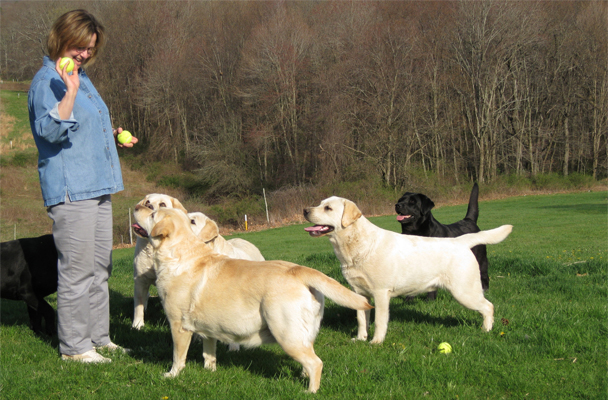
Labrador Retrievers are known for their intelligence, friendly nature, and boundless energy. Whether you’re a new dog owner or a seasoned Labrador enthusiast, training your Labrador with essential commands and tricks is crucial for a happy and well-behaved pet. This guide will walk you through the key commands and provide valuable tips to make your training sessions successful.
Why Train Your Labrador?
Training is fundamental for the safety and well-being of your Labrador. It helps in building a strong bond between you and your dog, provides mental stimulation, and ensures that your Labrador behaves appropriately in various situations. By teaching essential commands, you’ll be able to manage your dog’s behavior and create a harmonious environment at home.
Essential Commands
Sit
Command Overview:
Teaching your Labrador to sit on command is one of the most basic and useful commands. It helps your dog learn impulse control and is a foundation for more advanced training.
How to Teach “Sit”:
- Hold a treat close to your dog’s nose.
- Move your hand up, allowing your dog’s head to follow the treat while its bottom lowers.
- Once your dog is in a sitting position, say “Sit” and give the treat along with praise.
- Repeat this process several times daily until your dog masters it.
Stay
Command Overview:
The “Stay” command is essential for keeping your Labrador in one place, which is useful in various situations such as crossing the street or having guests over.
How to Teach “Stay”:
- Start with your dog in the “Sit” position.
- Open your palm in front of you and say “Stay.”
- Take a few steps back, maintaining eye contact.
- If your dog stays, reward it with a treat and praise.
- Gradually increase the distance and duration of the “Stay” command.
Come
Command Overview:
The “Come” command is crucial for ensuring your dog’s safety, especially in off-leash situations. It helps in recalling your dog to you immediately.
How to Teach “Come”:
- Attach a leash to your dog and stand a few feet away.
- Say “Come” in a cheerful tone while gently pulling the leash towards you.
- When your dog reaches you, reward it with a treat and praise.
- Practice this command in various environments to reinforce the behavior.
Heel
Command Overview:
Teaching your Labrador to “Heel” ensures that your dog walks beside you without pulling on the leash. This command is essential for enjoyable and safe walks.
How to Teach “Heel”:
- Start with your dog on a leash by your side.
- Say “Heel” and take a step forward, encouraging your dog to walk beside you.
- Reward your dog with treats and praise for staying in the correct position.
- Practice this command regularly, gradually increasing the duration and distance.
Training Tips and Techniques
Positive Reinforcement
Use positive reinforcement, such as treats and praise, to encourage good behavior. Reward your Labrador immediately after it performs the desired behavior to reinforce the connection between the command and the action.
Consistency
Be consistent in your commands and the way you give them. Use the same word and tone for each command to avoid confusing your dog.
Minimize Distractions
Start training in a quiet, familiar place to minimize distractions. Once your Labrador has mastered the commands in a controlled environment, gradually introduce new locations and distractions.
Short and Frequent Sessions
Keep training sessions short and frequent to maintain your dog’s attention. Aim for 5-10 minute sessions several times a day rather than one long session.
Gradual Difficulty Increase
Gradually increase the difficulty of commands by practicing in different environments and with various distractions. This helps your Labrador generalize the commands and respond reliably in any situation.
End on a Positive Note
Always end training sessions on a positive note. Finish with a command your dog knows well and reward it with a treat and praise. This leaves your Labrador feeling accomplished and eager for the next session.
Conclusion
Training your Labrador Retriever with essential commands and tricks is a rewarding experience that strengthens your bond and ensures a well-behaved pet. By following the steps and tips outlined in this guide, you’ll be well on your way to having a happy, obedient, and confident Labrador.
FAQs
1. How long does it take to train a Labrador Retriever?
Training duration varies based on the dog’s age, temperament, and consistency in training. Most Labradors can learn basic commands within a few weeks with regular practice.
2. What if my Labrador doesn’t respond to commands?
If your Labrador doesn’t respond to commands, ensure you’re using positive reinforcement and consistent commands. Patience and persistence are key. Consider seeking help from a professional trainer if needed.
3. Can older Labradors learn new commands?
Yes, older Labradors can learn new commands. While it may take a bit more time and patience, older dogs are capable of learning and benefiting from training just as much as younger ones.
4. How do I handle behavioral issues during training?
Address behavioral issues by identifying the root cause and using positive reinforcement to encourage good behavior. Consistency and patience are essential. For severe issues, consult a professional trainer.
5. How often should I train my Labrador?
Train your Labrador several times a day in short, 5-10 minute sessions. Consistent training helps reinforce commands and keeps your dog engaged and motivated.








